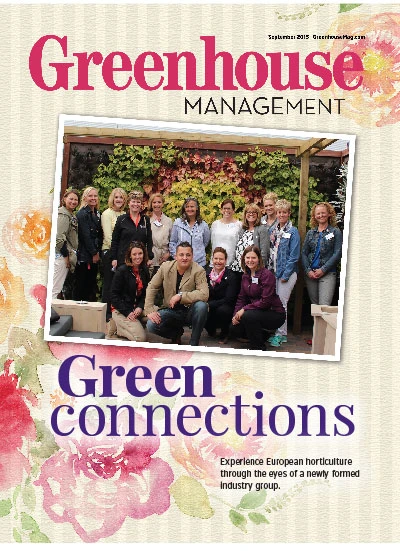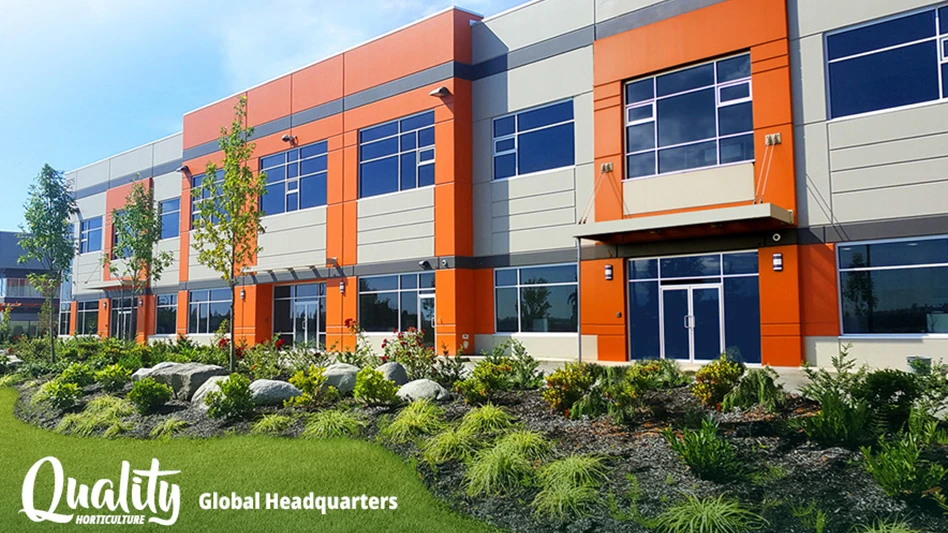 Light-emitting diode (LED) lighting is growing in popularity and improving technologically as growers are trialing and implementing LEDs into their operations. Here are two recent insights and projects from two of the industry’s top researchers.
Light-emitting diode (LED) lighting is growing in popularity and improving technologically as growers are trialing and implementing LEDs into their operations. Here are two recent insights and projects from two of the industry’s top researchers.
Part I of a two-part series. Next month, we bring you studies from Erik Runkle of Michigan State University and Cary Mitchell of Purdue University.
Controlling plant growth and behavior with light: a perspective
By Kevin M. Folta, professor and chair, University of Florida Horticultural Sciences Department
The magic in growing plants is that they do well with water, a sprinkle of critical nutrients and application of light. We usually associate light with the process of photosynthesis, and modern lighting regimes reflect this fundamental assumption. However, is simply providing photons to a plant necessarily the best way to support them, or maximize the value of plant-based products?
Light is not just the stuff that plants need to grow. Light is actually a mixture of information that can guide plant growth, development and productivity. Light is described by at least three parameters, including wavelength (color), fluence rate (intensity — sort of) and photoperiod (duration). Alteration of these variables can have a profound effect on plant biology, and plant product production. In nature, the relative amount of red, blue, green and invisible colors off the ends of the spectrum shift throughout the day and over a season. Some wavelengths tell plants about the position of neighbors or the density of vegetation.
We also know that different wavelengths have different effects on specific aspects of plant growth. In other words, when a plant cell in the leaf “sees” a blue photon, it provides specific instructions to the nucleus of the cell, changing which genes are turned on and off. Blue signals have been mechanistically linked to processes like bending toward light, production of purple pigments, control of flowering, leaf expansion and internode growth inhibition.
 On the other extreme, the invisible light energies beyond the red end of the spectrum provide different information through a different cellular light sensor. Information through this pathway affects leaf angle, promotes internode elongation and decreases chlorophyll accumulation. These are just a few of the changes initiated by exposure of “far-red” light, and are mediated far-red specific changes in gene expression.
On the other extreme, the invisible light energies beyond the red end of the spectrum provide different information through a different cellular light sensor. Information through this pathway affects leaf angle, promotes internode elongation and decreases chlorophyll accumulation. These are just a few of the changes initiated by exposure of “far-red” light, and are mediated far-red specific changes in gene expression.
The blue and far-red examples are just two of the known effects of specific wavelengths. The last two decades of plant research has described specific effects of UV light, blue, green, red and far-red radiation. This range of sensors and responses poses an important question. If discrete plant processes are controlled by different wavelengths, could we mix light ‘recipes’ that allow the grower to not just grow plants, but rather, control the way they grow?
This line of thinking is growing in popularity as scientists and growers consider clever tricks that elevate opportunities beyond the solar spectrum. The possibility to literally control the way a plant grows or behaves without the use of chemicals and labor is an attractive one.
Research at the University of Florida, Purdue University, Michigan State and others has shown the exciting potential of the technology. Application of specific colors can change flavors, colors, size, fresh weight and a variety of other important qualities. Evidence shows effects on growing plants as well as the harvested products.
But are university growth chamber experiments industry scalable? It is becoming reality. Over the last two decades light-emitting diodes (LEDs) have replaced bulbs from our household fixtures to the streets of Las Vegas. Their long lifetime and low power profiles have prompted their rapid adoption. As these types of lights have become more commonplace we’ve observed two common trends — the lights get brighter and the costs get lower.
Together these two trends have growers considering LED-based fixtures for day-length extension and product improvement, either as a sole source or as a spectral supplement. At the same time, corporate and university research is defining new edges of the application, unveiling interesting new angles that can maximize the genetic potential for any given plant, or allow fine control of important processes like the timing of flowering.
Controlling how plants grow and behave means speaking to them in a language they understand. Manipulation of the light spectrum is a relatively untapped variable that is poised to make great contributions to growing plants in protected and controlled environments.
‘LED it be’: 50-percent energy savings may be possible by the smart use of LEDs in greenhouse horticulture
By Dr. Leo Marcelis, Wageningen University - Chair group Horticulture and Product Physiology
 LEDs provide exciting new possibilities to modulate spectrum and direction of light, instantaneous control of light intensity, and the ability to separate lighting from heating. We just started a five-year research program called ‘LED it be.’ In this program, five Dutch universities and nine private companies (Philips, LTO Glaskracht, Nunhems, Bejo, Rijkzwaan, Plantenkwekerij Van der Lugt, Westlandse Planten Kwekerij, Hortimax, B-Mex) work together to fundamentally understand the responses of plant processes to many of the different features of light, and then translate this knowledge into management practices. The goal is to save 50-percent of energy output in greenhouse tomato production.
LEDs provide exciting new possibilities to modulate spectrum and direction of light, instantaneous control of light intensity, and the ability to separate lighting from heating. We just started a five-year research program called ‘LED it be.’ In this program, five Dutch universities and nine private companies (Philips, LTO Glaskracht, Nunhems, Bejo, Rijkzwaan, Plantenkwekerij Van der Lugt, Westlandse Planten Kwekerij, Hortimax, B-Mex) work together to fundamentally understand the responses of plant processes to many of the different features of light, and then translate this knowledge into management practices. The goal is to save 50-percent of energy output in greenhouse tomato production.
In the Netherlands, a tomato grower in a modern greenhouse with high-pressure sodium (HPS) lighting typically uses 3,100 microjoules (MJ/m2) of fossil energy per year, 80 percent of which consists of electricity for lighting (2,480 MJ/m2). The remaining 20 percent (620 MJ/m2) is mainly for heating and humidity control. Furthermore, 530 MJ/m2 of the lighting energy also contributes to fulfilling the energy demand for heating and humidity control.
The main obstacles to saving energy are in the departments of lighting and air humidity control. To realize an overall energy reduction of 50 percent, a 60 percent reduction of electricity use for lighting is required. Compared to HPS lighting, 30 percent reduction of electricity use can be realized by LED lighting due to a more efficient conversion from electricity to light. Improved light absorption by adapted canopy architecture and positioning of LEDs can save 15 percent electricity. This seems to be a realistic value if you consider that 5 to 7 percent of light from above is reflected by a canopy and 5 to 10 percent of the light is vanished unused in the floor. These losses can be reduced by interlighting. Furthermore, we calculated by a simulation model that adapted plant morphology can improve crop photosynthesis by 10 percent due to better light distribution. Diffusing greenhouse covers can increase crop growth by 5 to 10 percent, indicating that improving distribution of light absorption in a canopy is of great benefit.
Ten percent saving on electricity is expected to be realized by improved photosynthesis as the quantum yield of photosynthesis is spectrally dependent. Five percent saving on electricity is expected from improved assimilate partitioning.
We anticipate that more fruits will set and fewer fruits will abort, and that more assimilates (or sugars) will move out of the leaves into the fruit with the use of smart lighting. Furthermore, lighting will be used to enhance disease resistance of the crop and decrease transpiration at moments that transpiration leads to energy costs. The generated knowledge will be accumulated in a model-based management support system.
The program has just begun. At this moment, young plants of 40 different cultivars are grown in climate chambers under eight different light spectra. This serves as an initial screening of cultivars and light conditions for further research in this program.

Explore the September 2015 Issue
Check out more from this issue and find your next story to read.
Latest from Greenhouse Management
- North Carolina Nursery & Landscape Association announces new executive vice president
- Plant Development Services, Inc. unveils plant varieties debuting in 2025
- Promo kit available to celebrate first National Wave Day on May 3
- Applications now open for American Floral Endowment graduate scholarships
- Endless Summer Hydrangeas celebrates 20 years with community plantings
- Invest in silver
- Garden Center magazine announces dates for 2025 Garden Center Conference & Expo
- USDA launches $2 billion in aid for floriculture growers





